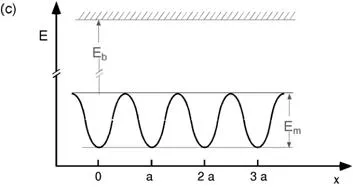Surface Mobility
Atomic-level monitoring of transport processes on crystal lattices
The transport of atoms or molecules at solid surfaces plays a key role in a multitude of surface physical and chemical processes : In heterogenous catalysis reaction partners usually adsorb and diffuse at the surface before the products form. Surface mobility is a prerequisite in associative thermal desorption. The equilibration of surface phases or the growth of regular films implies lateral motions of the respective adsorbed species. The formation of nanostructures at surfaces via self–assembly or diffusion limited aggregation requires a balancing of the mobility characteristics and the corresponding lateral interactions. Finally, the adsorption process of atoms or molecules per se may involve transient motions.
Atoms or molecules coming from the gas phase into contact with a surface atomic lattice thermalize with the phonon heat bath of the crystal upon adsorption. The adspecies similarly experiences the periodic corrugation of the substrate atomic lattice, which is illustrated in the figure below. The binding energy is thus subject to lateral variations with local minima corresponding to energetically favorable positions. These adsorption sites are separated by energy barriers being usually significantly smaller than the energy barrier for desorption.


STM images resolving (a) the hexagonal atomic structure of the close-packed fcc(111) surface and (b) the anisotropic fcc(110) surface of Ag. The surface unit cells and high symmetry directions are marked. (c) Schematic one-dimensional potential energy surface experienced by a simple indivdual adsorbate along a high-symmetry surface direction (Em: migration energy barrier; Eb: bonding energy; a: surface lattice constant).
In particular the motion of complex organic molecules plays a decisive role in the positioning of functional molecular species at selected sites of templates and the self-assembly of supramolecular nanostructures or layers at surfaces. Both translational and rotational motions need to be considered, and moreover, conformational changes may interfere. The detailed understanding of such phenomena is a mandatory issue in the present race for nanoscale control of matter and the development of future nanostructured functional materials, nanofabrication methodologies and devices. But also from the fundamental research point of view this field is rewarding, because it comprises new horizons and challenges in the exploration of the molecular world.


Surface migration of the rigid rodlike molecule 4-trans-2-(pyrid-4-yl-vinyl) benzoic acid on Pd(110). In (a) and (b) two consecutive STM images taken at 361 K are shown which demonstrate the 1-dim motion. Arrows indicate molecules whose position changed; circles mark fractionally imaged molecules moving under the STM tip in the course of the measurement. (c) Model for the flat adsorption geometry explaining the two observed molecular orientations in the STM data. The length of the molecule is 12.5 Å. (d) Arrhenius plot of single molecule hopping rates.
Key Papers
Mobility of complex organic species at metal surfaces" J.V. Barth, in Properties of Single Organic Molecules on Crystal Surfaces, P. Grütter, W. Hofer and F. Rosei, eds., World Scientific, Singapore (2006)
"Mobility and bonding transition of C60 on Pd(110)" J. Weckesser, J.V. Barth and K. Kern, Phys. Rev. B 64, 161404 (R) (2001)
Transport of adsorbates at metal surfaces : From thermal migration to hot precursors" J.V. Barth, Surf. Sci. Rep. 40, 75 (2000)
Direct observation of surface diffusion of large organic molecules at metal surfaces : PVBA on Pd(110)" J. Weckesser, J.V. Barth and K. Kern, J. Chem. Phys. 110, 5351 (1999).
Direct observation of mobility and interactions of oxygen molecules chemisorbed on the Ag(110) surface" J.V. Barth, T. Zambelli, J. Wintterlin, R. Schuster and G. Ertl, Phys. Rev. B 55, 12902 (1997)